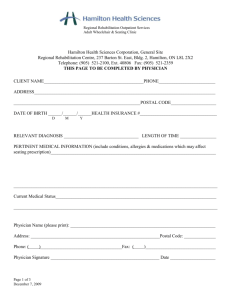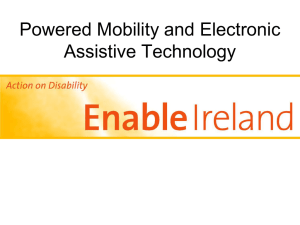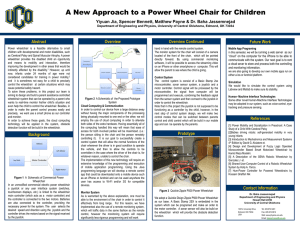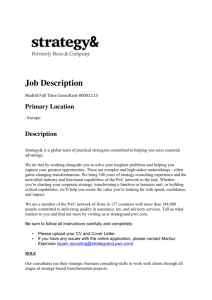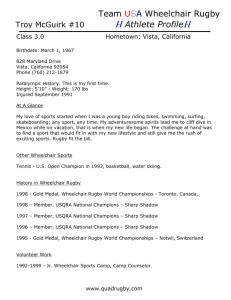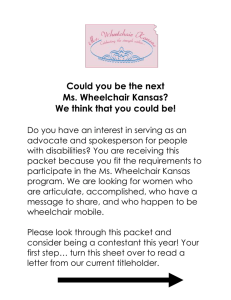To Bill or Not to Bill - Georgia Association of Medical Equipment
advertisement
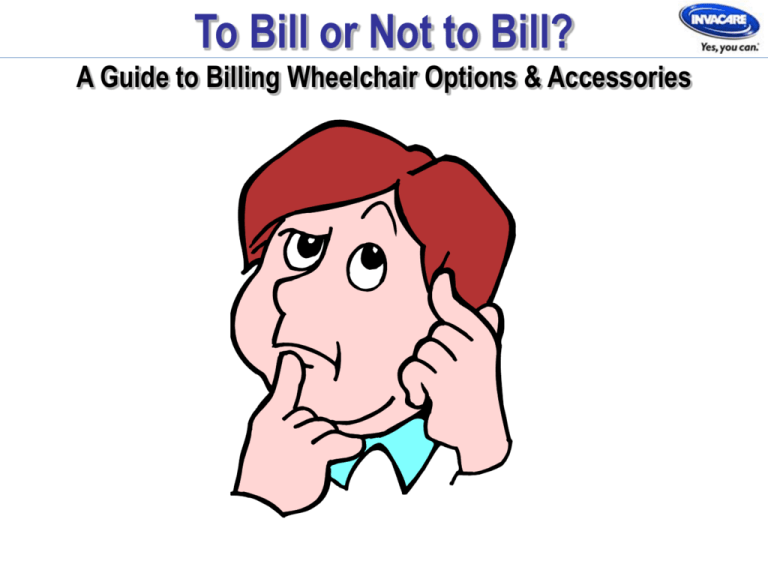
To Bill or Not to Bill? A Guide to Billing Wheelchair Options & Accessories Learning Objectives • Identify at least 3 separately billable wheelchair accessories for manual and power wheelchairs to help maximize reimbursement • Identify at least 2 appropriate medical justifications for each separately billable wheelchair accessories • Identify current and updated HCPCS coding • Discuss coding for wheelchair options/accessories when provided as a replacement item Agenda • Power Mobility • Manual Wheelchairs • Seating & Positioning • Wheelchair Accessories • Power Wheelchair Electronics • Powered Seating • Repair and Replacement Power Mobility Devices POV Basic Equipment Package • Batteries • Battery chargers • Complete set of tires • Tiller steering • All accessories necessary for safe operation • Non-expandable controller with proportional response to input • Weight appropriate upholstery and seating system PWC Basic Equipment Package • Lap belt or safety belt. (Shoulder or chest harness/straps/vest may be billed separately) • Battery charger, single mode • Complete set of tires and casters, any type • Legrests. (Elevating legrests may be billed separately) • Footrests/foot platform. (Angle adjustable footplates may be billed separately with Group 3, 4 and 5 PWCs) • Armrests. (Adjustable height arms may be billed separately) • Weight specific components required for weight capacity PWC Basic Equipment Package • Any back width or seat width and depth. (Group 3 or 4 PWCs with a sling/solid seat/back, may bill separately: – For Standard Duty, seat width and/or depth greater than 20” – For HD, seat width and/or depth greater than 22” – For VHD, seat width and/or depth greater than 24” – For EHD, no separate billing • Controller and Input Device. (expandable controller, a nonstandard joystick, or other alternative control device may be billed separately) Codes Included in Initial Group 1 and 2 PWC E0971 E0978 E0981 E0982 E0995 E1225 E2366 E2367 E2368 E2369 E2370 E2374 E2375 E2376 E2381 E2382 E2383 E2384 E2385 E2386 E2387 E2388 E2389 E2390 E2391 E2392 E2393 E2394 E2395 E2396 K0015 K0017 K0018 K0019 K0020 K0037 K0040 K0041 K0042 K0043 K0044 K0045 K0046 K0047 K0051 K0052 K0098 Codes Included in Initial Group 3 and 4 PWC E0971 E0978 E0981 E0982 E0995 E1225 E2366 E2367 E2368 E2369 E2370 E2374 E2375 E2376 E2381 E2382 E2383 E2384 E2385 E2386 E2387 E2388 E2389 E2390 E2391 E2392 E2393 E2394 E2395 E2396 K0015 K0017 K0018 K0019 K0020 K0037 K0041 K0042 K0043 K0044 K0045 K0046 K0047 K0051 K0052 K0098 Manual Wheelchair Bases Standard Features • The following features are included in the allowance for all adult manual wheelchairs: – Seat Width: 15” – 19” – Seat Depth: 15” – 19” – Arm Style: Fixed, swingaway, or detachable; fixed height – Footrests: Fixed, swingaway, or detachable Codes Included in Initial MWC E0967 E0981 E0982 E0995 E2205 E2206 E2210 E2220 E2221 E2222 E2223 E2224 E2225 E2226 K0015 K0017 K0018 K0019 K0042 K0043 K0044 K0045 K0046 K0047 K0050 K0052 K0069 K0070 K0071 K0072 Seating & Positioning • General Use • Positioning • Skin Protection • Skin Protection & Positioning General Use Wheelchair Seat Cushion Justifications: • • Covered for a patient that has a Medicare covered wheelchair If the patient does not have a covered WC, the cushion will be denied as not medically necessary. HCPCS Codes E2601: Width Less Than 22”, Any Depth E2602: With 22” or Greater, Any Depth Skin Protection Justifications: 1.The patient has a Medicare covered WC, and 2.The patient has either of the following: a. Current pressure ulcer or a past history of a pressure ulcer (707.03 707.05) on area of contact with the seating surface; or b. Absent or impaired sensation in the area of contact with the seating surface or inability to carry out a functional weight shift due to one of the following diagnoses: SCI resulting in quadriplegia or paraplegia, other spinal cord disease, MS, other demyelinating disease, CP, anterior horn cell disease including ALS, post polio paralysis, TBI resulting in quadriplegia, spina bifida, childhood cerebral degeneration, Alzheimer’s disease, Parkinson’s disease HCPCS codes E2603: Width Less Than 22”, Any Depth E2604: Width 22” or Greater, Any Depth Positioning Justifications: 1.The patient has a Medicare covered WC; and 2.The patient has any significant postural asymmetries that are due to one of the diagnoses listed for skin protection or to one of the following diagnoses: Monoplegia of the lower limb, Hemiplegia (due to stroke, TBI, or other etiology), MD, Torsion Dystonias, Spinocerebellar Disease HCPCS codes: E2605: Width Less than 22”, Any Depth E2606: Width 22” or Greater, Any Depth Skin Protection and Positioning Justifications: • A non-adjustable skin protection and positioning seat cushion, or an adjustable skin protection and positioning seat cushion is covered for a patient who meets the criteria for both a skin protection and positioning seat cushion. HCPCS codes E2607: Width Less that 22”, Any Depth E2608: Width 22” or Greater, Any Depth General Use Wheelchair Back Cushion Justifications: • Covered for a patient who has a Medicare covered WC. • If the patient does not have a covered w/c, then the cushion will be denied as not medically necessary. HCPCS codes E2611: Width less than 22”, Any Height, Including Any Type Mounting Hardware E2612: Width 22” or Greater, Any Height, Including Any Type Mounting Hardware Positioning: Posterior/Lateral Justifications: Covered for a patient who meets both of the following criteria: 1. The patient has a Medicare covered WC; and 2. The patient has any significant postural asymmetries that are due to one of the diagnoses listed under the justification criteria for a skin protection cushion, or to one of the following diagnoses: Monoplegia of the lower limb, Hemiplegia (due to stroke, TBI, or other etiology),MD, Torsion Dystonias, Spinocerebellar Disease HCPCS codes E2615: Width Less Than 22”, Any Height, Including Any Type Mounting Hardware E2616: Width 22” or Greater, Any Height, Including Any Type Mounting Hardware Positioning: Planar with Lateral Supports Justifications: Covered for a patient who meets both of the following criteria: 1. The patient has a Medicare covered WC; and 2. The patient has any significant postural asymmetries that are due to one of the diagnoses listed for skin protection or to one of the following diagnoses: Monoplegia of the lower limb, Hemiplegia (due to stroke, TBI, or other etiology), MD, Torsion Dystonias, Spinocerebellar Disease HCPCS Codes E2620: Width Less than 22”, Any Height, Including Any Type Mounting Hardware E2621: Width 22” or Greater, Any Height, Including Any Type Mounting Hardware Custom Fabricated Seat Cushion and Back Justifications: HCPCS Codes E2609: Seat Cushion E2617: Back Cushion A custom fabricated seat cushion is covered if criteria (1) and (3) are met. A custom fabricated back cushion is covered if criteria (2) and (3) are met: 1. Patient meets all of the criteria for a prefabricated skin protection seat cushion or positioning seat cushion; 2. Patient meets all of the criteria for a prefabricated positioning back cushion; 3. There is a comprehensive written evaluation by a licensed clinician (who is not an employee of or otherwise paid by a supplier) which clearly explains why a prefabricated seating system is not sufficient to meet the patient’s seating and positioning needs. Wheelchair Cushion – Coding Guidelines • No separate payment for solid seat/back inserts (rigidizer) • No separate payment for mounting hardware • Seat/back cushions not PDAC verified must be billed K0669. • Pediatric size cushions and positioning accessories are billed using same codes • What to do for patients who do not have a qualifying diagnosis? Swingaway Hardware Code: E1028, each • Used for hardware that allows the following items to retract, swingaway or be removed: − headrests (E0955), − lateral trunk or hip supports (E0956) − medial thigh supports (E0957) Justifications – Allows accessories to swing away to allow close access to tables, sinks and desks, giving the client increased independence in performing MRADLs – Permits safe transfers to bed and commodes. Head Rests Head rests − Code: E0955 Coverage criteria: − Diagnosis driven, or − Patient has a covered manual or power tilt and/or recline seating system. Lateral Trunk Supports Lateral trunk supports − Code: E0956, each Justifications: – Client has lack of trunk control due to loss of muscle function, abnormal tone or reflexes – Needed to correct or accommodate scoliosis that may worsen and cause respiratory, skin and digestive problems – Needed to provide proximal control so client may function distally using their upper extremities (ex. eating, driving, writing) Medial Knee Support Medial knee support – Code: E0957, each Justifications: – Client is at risk for or has hip subluxation or dislocation and needs support to hold joint in safest posture – Client assumes an adduction pattern, due to tone, abduction breaks up tone – Client needs to maintain ROM for hygiene and toileting Seat Positioning Strap Seat positioning strap − Code: E0978, each − Included on power mobility devices Justifications: − Needed to provide proper positioning of the pelvis − Client can’t maintain pelvic control assuming poor postures allowing development of deformities and skin breakdown − Client thrusts or extends and slides out of their seat Chest Positioning Strap Chest positioning strap − Code: E0960, each Justifications: – Client has moderate to severe decrease in trunk control, can’t function without added support – Client can’t use tilt/recline due to primitive reflexes, needs chest support to hold body up against gravity – Client has rotational posture and needs pressure in the front of the body for control Wheelchair Accessories Adjustable Height Arms Codes – E0973, each (detachable) – K0020, pair (fixed) Coverage criteria: – Covered if patient requires arm height different than that available using non-adjustable height arms – Patient spends at least 2 hours per day in the WC Adjustable Height Arms Justifications: – Standard arm is too high/low causing client to assume poor positions to use arms as support – Client needs the armrest to be a particular height for transfers and weight shifts – Client has poor shoulder integrity and arms need to be at a particular height for support Adjustable Angle Footplates Code: K0040, each Justifications: – Needed because the client has a contracture to accommodate. – Needed because the client has hamstring tightness that needs to be accommodated, makes a STD 60 or 70 footrest a tighter or more open angle. – Needed because the client wears AFO’s and needs the footrest to accommodate to the set angle. – Needed to decrease the tone involved with thrusting from the chair. Foot Positioning Options Codes: – Heel loops – E0951, each – Toe loops – E0952, each – Leg straps – K0038, each – H-style straps – K0039, each Justifications: – Provides safety for the feet that fall off the footrests because of tone, primitive reflexes or lack of control – Prevents hyperflexion or extension at the knee Large Size Footplates Code: K0041, each – Included on power mobility devices Justifications: – Needed to provide full contact and support of the foot to control a tendency to go into a poor posture. – Needed to provide full contact and support of the foot to control primitive reflexes that start at the foot like positive supporting reflex or extensor thrust. Manual Elevating Legrests Code: E0990, each (purchase) Code: K0195, pair (capped rental) Coverage criteria: − Patient has musculoskeletal condition or the presence of a cast/brace that prevents 90 degree flexion at the knee − Patient has significant edema of the lower extremities that requires having an ELR − Patient meets the criteria for and has a reclining back on the wheelchair Manual Elevating Legrests Justifications: – Limited range of motion. – Reduction of edema if combined with recline or tilt. – Differs positioning for comfort. – Client has BKA, splint or prosthesis which requires support in an extended position. Wheel Lock Extensions Code: E0961, each Justifications: – Client does not have the strength, ROM or pattern of movement to apply standard brakes. – Poor balance keeps client from reaching a standard brake. – Client is unable to grasp standard size brake. – One Upper extremity is non-functional requiring the opposite to cross over and apply the brakes. Flat Free Tires Code: E2213,each Justifications: – History of frequent repairs, more cost effective. – Terrain has potential to cause frequent flats. – Client travels far from home in chair and it would be a safety issue if he/she got a flat. – Client lives in a rural location and does not have easy access to the supplier for repairs. Shock Absorbers Code: E1015, each (MWC) Code: E1016, each (PWC) Justifications: – Needed to reduce spasticity caused by shock or vibration. – Allows the client with poor trunk control to maintain better alignment which is important for posture and skin integrity – Provides better endurance for sitting because of decreased pain. – Provides better endurance for pushing the chair because the chair does not meet as much resistance on uneven terrain. – Needed because client transfers from a high surface and needs to cushion the shock to his/her buttocks due to poor or at risk skin integrity. Manual Fully Reclining Back Code: E1226 Coverage criteria: • Patient spends at least 2 hours per day in the wheelchair and has 1 or more of the following conditions/needs: – Quadriplegia – Fixed hip angle – Trunk or LE casts/braces require recline for positioning needs – Excess extensor tone of the trunk muscles – Rests in recumbent position 2+ times/day and transfers are difficult Manual Fully Reclining Back Justifications: – Patient needs to weight shift due to skin breakdown – Patient needs to lie flat to empty their bladder – Patient breathes better in recline position – Patient needs to control severe lower extremity edema – Patient needs to lie flat for transfers Rear Anti-Tipper Code: E0971, each Justifications: – Client rocks in their chair, unsafe without anti-tippers – Client has extreme extensor tone – Client often comes down hard into chair during transfers causing chair to tip backwards – Client utilizes a ramp and is unable to compensate by bringing weight forward Nonstandard Seat Frame - MWC Codes: – E2201 – width 20” to 22” – E2202 – width 24” to 27” – E2203 – depth 20” to 21” – E2204 – depth 22” to 25” Justifications: – Patient’s physical size justifies the need for extended seat width or depth. Power Wheelchair Electronics Electronics Terminology • Interface - mechanism that controls the movement of a power wheelchair. Examples of interfaces include: joystick, sip and puff, chin control, head control, etc. • Proportional Interface - the direction and amount of movement by the patient controls the direction and speed of the wheelchair. One example of a proportional interface is a standard joystick. • Non-Proportional Interface - involves a number of switches. Selecting a particular switch determines the direction of the wheelchair, but the speed is pre-programmed. One example of a non-proportional interface is a sipand-puff mechanism. • Controller - the microprocessor and other related electronics that receive and interpret input from the drive control interface and convert that input into power output which controls speed and direction. A high power wire harness connects the controller to the motor and gears. Electronics Terminology • Switch - an electronic device which turns power to a particular function either "on" or "off". The switch may be either mechanical or non-mechanical. – Mechanical switches require physical contact to be activated. Examples include: toggle, button, ribbon, etc. – Non-mechanical switches do not require physical contact to be activated. Examples include: proximity, infrared, etc. – Some codes include multiple switches. Each switch may have its own external component, may be integrated into a single external component or may be integrated into the driver control without an external component. Electronics Terminology • Stop Switch - allows for an emergency stop when a wheelchair with a nonproportional interface is operating in the latched mode. May be referred to as a kill switch. • Direction Change Switch - allows a switch to initiate forward movement one time and backward movement another time. • Function Selection Switch - allows the patient to determine what operation is being controlled by the interface at any particular time. Operations may include: drive forward, drive backward, tilt forward, recline backward, etc. • Integrated Proportional Joystick and Controller - an electronics package in which a joystick and controller electronics are in a single box, which is mounted on the arm of the wheelchair. Power Wheelchair Electronics • E2312 - PWC accessory, hand or chin control interface, mini-proportional remote joystick, proportional, including fixed mounting hardware – Separately billable in addition to an expandable controller both at initial issue and with replacement of the expandable controller – Activated by approx. 25 grams of force – Has max excursion 5 mm from neutral – Can only be used with an expandable controller. – Used for hand, chin or by other body part control (e.g., tongue, lip, finger tip) – No separate billing for control buttons, displays, switches, or fixed mounting hardware, regardless of the body part used to activate the joystick. Power Wheelchair Electronics • E2313 - PWC accessory, harness for upgrade to expandable controller, including all fasteners, connectors and mounting hardware, each – Includes all the wires, fuse boxes, fuses, circuits, switches and all the necessary fasteners, connectors, and mounting hardware required for the operation of an expandable controller. Power Wheelchair Electronics • E2321 - PWC accessory, hand control interface, remote joystick, non-proportional, including all related electronics, mechanical stop switch, and fixed mounting hardware. – Used for a non-proportional remote joystick used for either a hand or chin control. Power Wheelchair Electronics • E2322 - PWC accessory, hand control interface, multiple mechanical switches, non-proportional, including all related electronics, mechanical stop switch, and fixed mounting hardware – Describes a system of 3-5 mechanical switches activated by the patient touching the switch. The switch selected determines the direction of the wheelchair. – A mechanical stop switch and a mechanical direction change switch, if provided, are included in the allowance for the code. Power Wheelchair Electronics • E2323 - PWC accessory, specialty joystick handle for hand control interface, prefabricated – Includes handles with a shape other than a straight stick (i.e. U-shape or T-shape) – Handles that have other nonstandard features (i.e. flexible shaft) Power Wheelchair Electronics • E2324 - PWC accessory, chin cup for chin control interface – When code E2312, E2321, E2373, or E2374 is used for a chin control interface, the chin cup is billed separately with code E2324. Power Wheelchair Electronics • E2325 - PWC accessory, sip and puff interface, non-proportional, including all related electronics, mechanical stop switch, and manual swingaway mounting hardware – A sip and puff interface is a nonproportional interface in which the patient holds a tube in their mouth and controls the wheelchair by either sucking in (sip) or blowing out (puff). A mechanical stop switch is included in the allowance for the code. Power Wheelchair Electronics • E2326 - PWC accessory, breath tube kit for sip and puff interface – Billed in addition to E2325 when a sip n puff interface is provided. Power Wheelchair Electronics • E2327 - PWC accessory, head control interface, mechanical, proportional, includes all related electronics, mechanical direction change switch, and fixed mounting hardware – A headrest is attached to a joystick-like device. – The direction and amount of movement of the patient's head pressing on the headrest control the direction and speed of the wheelchair. – A mechanical direction control switch is included in the code. Power Wheelchair Electronics • E2328 - PWC accessory, head control or extremity control interface, electronic, proportional, including all related electronics and fixed mounting hardware – A patient's head or extremity movements are sensed by a box placed behind the patient's head or extremity. – The direction and amount of movement of the patient's head or extremity control the direction and speed of the wheelchair Power Wheelchair Electronics • E2329 - PWC accessory, head control interface, contact switch mechanism, non-proportional, including all related electronics, mechanical stop switch, mechanical direction change switch, head array, and fixed mounting hardware – A patient activates one of three mechanical switches placed around the back and sides of the head by pressure of the head against the switch. – The switch selected determines the direction of the wheelchair. – A mechanical stop switch and direction change switch are included in the allowance for the code. Power Wheelchair Electronics • E2330 - PWC accessory, head control interface, proximity switch mechanism, nonproportional, including all related electronics, mechanical stop switch, mechanical direction change switch, head array, and fixed mounting hardware – The patient activates one of three switches placed around the back and sides of their head. – The switches are activated by movement of the head toward the switch, the head does not actually touch the switch. – The switch selected determines the direction of the wheelchair. – A mechanical stop switch and direction change switch is included in the allowance for the code. Power Wheelchair Electronics • E2331 - PWC accessory, attendant control, proportional, including all related electronics and fixed mounting hardware – Allows a caregiver to drive the WC instead of the patient – This code is limited to proportional control devices, usually a joystick mounted on the rear canes of the WC – An attendant control is covered in place of a patientoperated driver control if the patient meets coverage criteria for a WC, is unable to operate a MWC or PWC and has a caregiver who is unable to operate a MWC but is able to operate a PWC. – If an attendant control is provided in addition to a patient operated driver control, it is denied as non-covered. Power Wheelchair Electronics • E2373 - PWC accessory, hand or chin control interface, compact remote joystick, proportional, including fixed mounting hardware – Has a max excursion of 15 mm from neutral – Requires approx. 340 grams of force to activate – Can only be used with an expandable controller – Can be used for hand, chin or other body part (e.g., foot, amputee stump, etc.) – No separate billing for control buttons, displays, switches, or fixed mount hardware regardless of the body part used to activate the joystick. Power Wheelchair Electronics • E2374 - PWC accessory, hand or chin control interface, standard remote joystick (not including controller), proportional, including all related electronics and fixed mounting hardware, replacement only – Joystick is typically mounted on the arm of the wheelchair and the controller is located under the seat of the wheelchair – The joystick is connected to the controller through a low power wire harness – May be used for either hand control, chin control, or attendant control – Requires approx 340 grams of force to activate – Has an excursion of 25 mm from neutral – Can be used with a non-expandable or an expandable controller – There is no separate billing for an E2374 joystick when it is provided at the time of initial issue of a PWC Power Wheelchair Electronics • E2375 - PWC accessory, non-expandable controller, including all related electronics and mounting hardware, replacement only – A non-expandable controller has the following features: • Has the ability to control up to 2 power seating actuators through the drive control (requires the use of E2310-E2311.) • Can accommodate only an integrated joystick or a standard proportional remote joystick. • May allow for the incorporation of an attendant control. Power Wheelchair Electronics • E2376 - PWC accessory, expandable controller, including all related electronics and mounting hardware, replacement only – May only be used for replacement of an expandable controller. • E2377 - PWC accessory, expandable controller, including all related electronics and mounting hardware, upgrade provided at initial issue – Used if an expandable controller is provided at the time of initial issue for power wheelchairs capable of being upgraded to an expandable controller (K0835 -K0891). Power Wheelchair Electronics • An expandable controller is capable of accommodating one or more of the following additional functions: – Other types of proportional input devices (e.g., mini or low-force joysticks, touchpads, chin control, head control, etc.) – Non-proportional input devices (e.g., sip and puff, head array) – Operate 3 or more powered seating actuators through the drive control. (requires the use of E2310-E2311.) • An expandable controller may also be able to operate one or more of the following: – A separate display (i.e., for alternate control devices) – Other electronic devices (e.g., control of an augmentative speech device or computer through the chair's drive control) – An attendant control Power Wheelchair Electronics • K0108 - PWC accessory, not otherwise classified interface, including all related electronics and any type mounting hardware (E2399 was deleted 01/01/2010) – Appropriately used at the time of initial issue only when: • the drive control interface provided is not included in the base code and there is no specific E code which describes it. – Appropriately used at the time of replacement only when: • An integrated joystick and controller box are being replaced due to damage • An interface other than a remote joystick (e.g. sip and puff, head control) is being replaced but the controller is not being replaced; or • There is no specific E code which describes the type of drive control interface system which is provided. Power Wheelchair Electronics • E1028 - Swingaway, retractable, removable hardware. • Used for: – remote joysticks or touchpads, – head control interfaces E2327-E2330, and – an indicator display box related to the multimotor electronic connection codes E2310 or E2311. • Code E1028 is not used with a sip and puff interface because it is included in the allowance for E2325. Miscellaneous Switches - K0108 Electronic Switches Mechanical Switches • Fiber Optic Switch • Egg Switch • Mini Fiber Optic Switch • Lip Switch • Proximity Switch • Wobble Switches • Adjustable Proximity Switch • Pneumatic Switches • Adjustable Beam Switch • Microlite Switches • Motion Concepts Push Buttons • Motion Concepts Single Toggle Powered Seating Tilt Recline Combination Tilt & Recline Seat Elevation Standing Powered Seating Coverage Criteria A power tilt, recline or tilt and recline, with or w/o power ELRs, is covered if 1 and 2 are met and if one of 3, 4 or 5 are met: 1. The patient meets all the coverage criteria for a power wheelchair; and 2. A specialty evaluation by a licensed/certified medical professional, such as a PT/OT or physician of the patient’s seating and positioning needs; and 3. The patient is at high risk for development of a pressure ulcer and is unable to perform a functional weight shift; or 4. The patient utilizes intermittent catheterization for bladder management and is unable to independently transfer from the wheelchair to bed; or 5. The power seating system is needed to manage increased tone or spasticity. E1002 – E1008 Bundling Rules E0973 K0015 K0017 K0018 K0019 K0020 K0042 K0043 K0044 K0045 K0046 K0047 K0050 K0051 K0052 Power Tilt (E1002) Justifications: • Weight Shift: – Need to weight shift because they have or are at great risk for skin breakdown. • Tone Management: – Can’t use recline because the stretch on the muscles triggers more spasticity. • Respiratory: – Needed because client breathes better in tilt position allowing lung expansion. • Vision: – Due to severe deformity tilt is required to correct the clients visual field • Hypotension: – Needed for client to accommodate to BP changes without losing consciousness. • Trunk Control – Allows the person to sit upright due to lack of trunk muscle strength. • Swallowing: – Needs tilt to reduce tone around the esophagus to allow independent swallowing. Power Recline (E1004) Justifications: • Weight Shift: – Need to weight shift because they have or are at great risk for skin breakdown − They need more weight redistribution than tilt, tilt does not provide enough relief. • Toileting: – Toileting and bladder emptying needs to happen in the chair and they need to lie flat to empty their bladder. • Respiratory: − Needed because client breathes better because the recline allows lung expansion. • Transfers: − Client needs to lie flat to transfer (vent dependent, poor neck control, etc) • Circulation: − Needed to control lower extremity edema. Power Tilt/Recline (E1007) Justifications: • Clients skin is so fragile they need the combination of tilt and recline to decrease the effects of shearing and to increase weight distribution over the largest surface area possible. • Need tilt as primary weight shift to control spasticity and posture, but need recline so they may empty their bladder or transfer flat. • Power tilt/recline is needed for pain relief. • Severe lower extremity edema and this the only way to get their lower extremities over their heart. Controlling Power Seating through Driver Control “One Power Seating System Motor” “Two or More Power Seating System Motors” Controlling Power Seating through Driver Control • E2310 - PWC accessory, electronic connection between wheelchair controller and one power seating system motor, including all related electronics, indicator feature, mechanical function selection switch, and fixed mounting hardware • E2311 - PWC accessory, electronic connection between wheelchair controller and two or more power seating system motors, including all related electronics, indicator feature, mechanical function selection switch, and fixed mounting hardware – Payment includes: • Function selection switch - allows the patient to select the motor that is being controlled • Indicator feature - shows which function has been selected. May be in a separate display box or integrated into the wheelchair interface. • Fixed mounting hardware for the control and display box (if present). Controlling Power Seating through Driver Control Justifications: • Allows the client to control the tilt/recline mechanism through the drive controller independently • Allows the seating system to be speed controlled to: – decrease the effects of spasticity or abnormal reflexes – allow the client to control upper extremities • Allows the seating system to be programmed to limit tilt/recline angles because – the client gets disoriented when they tilt or recline too far back – the client can not go into a full upright position due to poor trunk control • Allows the tilt and recline control to be programmed to work in a specific order/direction because the client can only use specific movements in a tilt or recline position Repair and Replacement Repair Policy Update • Effective November 4, 2014 • If Medicare paid for the base equipment initially, medical necessity for the base equipment has been established • Contractors are to only review the necessity of the repair and make a payment determination • The necessity of the repair must be addressed in either the physician's or the supplier's records. • Medical Records are not required to address the medical necessity of the base equipment but shall address the continued medical necessity of the item being repaired. Documentation is considered timely when it is on record during the preceding 12 months • Medicare contractors shall not require a face-to-face examination for repair of items already covered and paid for by Medicare. Change Request 8864 • Effective 01/05/2015 • Provides instructions for CB wheelchair accessories furnished for use with non-CB bid wheelchair bases to beneficiaries residing in a CBA. • Suppliers with claims that have been incorrectly paid or denied will need to submit appeal requests to the DME MAC's Reopening department. • If multiple claims are involved, you may submit a single reopening request for all affected claims via spreadsheet. • A separate spreadsheet should be submitted for each PTAN. • Each spreadsheet must include the PTAN, beneficiary's name, Health Insurance Claim Number (HICN), and claim control number (CCN). • If it has been more than one year since the claim was processed, request a waiver to timely filing. The reason for appeal/reopening should state "KY Modifier Processing Issues Resolved Under CR 8864." Repair Rules • Repairs definition – To fix or mend and to put the equipment back in working condition after damage or wear • Covered when necessary to make the equipment serviceable • If expense exceeds estimated expense of purchasing or renting another item for the remaining period of medical need, no payment can be made for the amount of the excess • Not covered for previously denied/non-covered equipment or equipment in the frequent and substantial servicing category • Not covered during 13 month capped rental period • No Medicare payment for travel time or equipment pickup and/or delivery • A new CMN and/or physician’s order is not required Repairs: Coding and Modifiers • K0108 - Wheelchair component or accessory, not otherwise specified • When billing code K0108 the following information is required: ‒ If multiple miscellaneous accessories are provided, each should be billed on a separate claim line using code K0108 ‒ Description of the item, brand name, make/model, and part number (use abbreviations when needed). • The brand name can be abbreviated by using just the first 5 letters. • Do not abbreviate the model/part number Repairs: Coding and Modifiers • K0739 - Repair or non-routine service for durable medical equipment other than oxygen requiring the skill of a technician, labor component, per 15 minutes • One unit of service = 15 minutes • Claims for repairs must include narrative information itemizing each repair and the time taken for each repair • Claims for replacement items and labor (K0739) must also include information in the NTE 2300 segment – Example: “RPRs to PT owned IVC Pronto M51 K0011 PWC PUR 041613” Repairs: Coding and Modifiers • RB: Replacement of a part of DME furnished as part of a repair – Indicates replacement parts of DMEPOS furnished as part of the service for repairing the DMEPOS item (base equipment/device) • When billing for the replacement of an accessory, there must be specific information notated in the NTE 2300 segment of the electronic claim – – – – Description of the base piece of equipment HCPCS code Date of purchase of the base piece of equipment “PT OWNED INVACARE ATM TAKE ALONG CHAIR PWC PUR 111612” • Each claim line for each replacement part must include a description of the reason why the item is being replaced – These details should be notated in the NTE 2400 segment of the electronic claim – Example: “RPL K0019 BBR” or “RPL arm pad destroyed” Repairs: Additional Information Equipment Part Repaired/Replaced Units of Service PWC Batteries 2 PWC Joystick 2 PWC Charger 2 PWC Motors 2/3 PWC Shroud 2 PWC/MWC Wheel/Tire 1 PWC/MWC Armrest/Pad 1 MWC Anti-tipper 1 Replacement Rules • Replacement of DME may occur in cases of loss, irreparable damage or irreparable wear – Irreparable Damage • Specific accident or a natural disaster • Equipment may be replaced in cases of loss or irreparable damage • New order/CMN required – Irreparable Wear • Deterioration sustained from day-to-day usage over time • Replacement due to irreparable wear takes into consideration the reasonable useful lifetime of the equipment • New order/CMN required Replacement Rules • Useful Lifetime – Determined through program instructions – In absence of specific instructions, contractors may determine the reasonable useful lifetime of equipment but in no case can it be less than 5 years – Computation is based on when the equipment was delivered – Replacement due to wear is not covered during the reasonable useful lifetime • Medicare will cover repair up to the cost of replacement, but not the actual replacement • RA: Replacement of a DME item – Denotes instances where an item is furnished as a replacement for the same item which has been lost, stolen or irreparably damaged Thank You For Your Time! Jim Stephenson Rehab Reimbursement and Coding Manager Invacare Corporation jstephenson@invacare.com www.invacare.com

